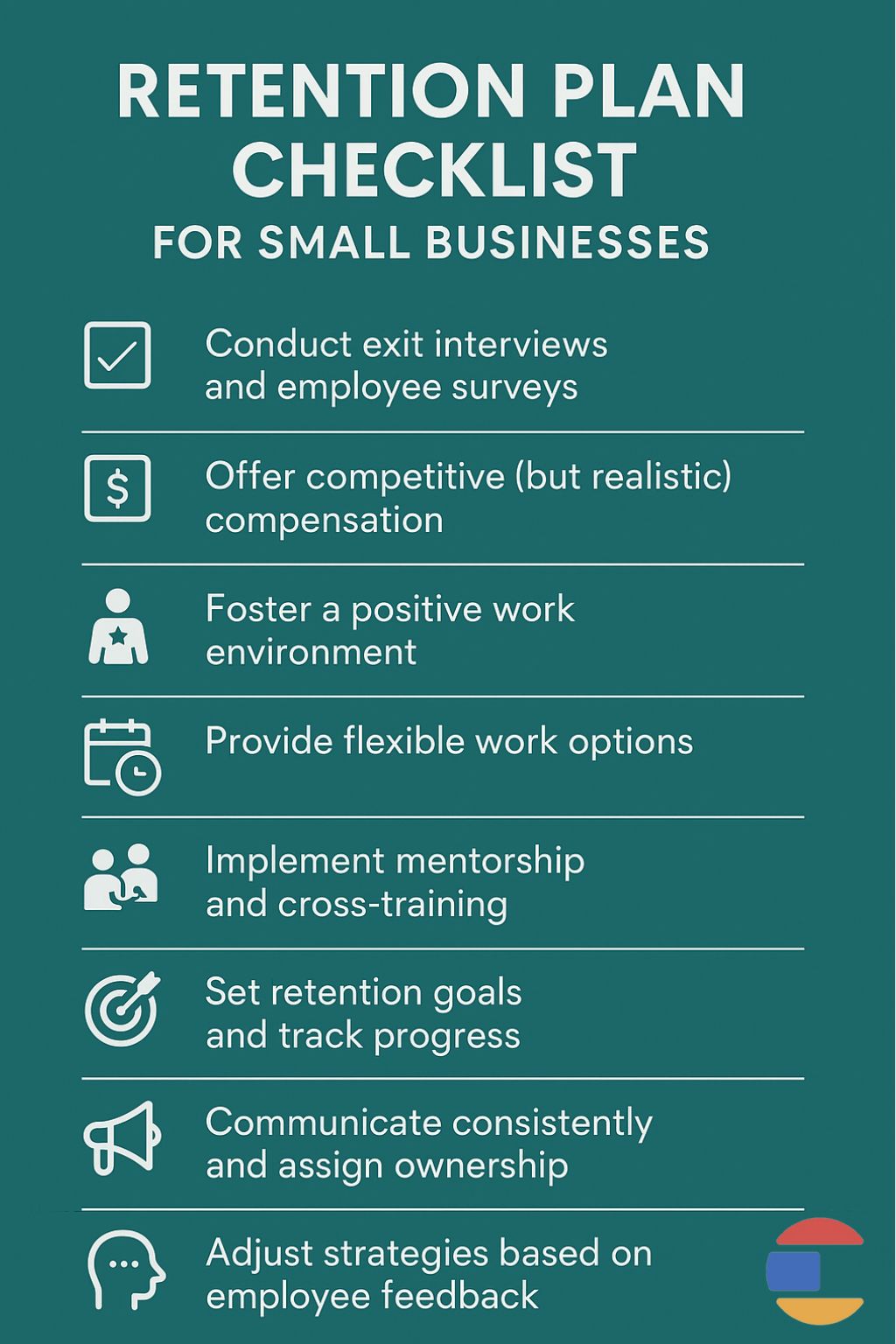How to Create an Employee Retention Plan Without Big Company Budgets
.png)

Enter your info to receive the guide instantly.
Ever felt like you're playing tug-of-war with the job market and losing? Small business owners across the globe are struggling to hold on to great employees while competing with big-name companies that offer higher salaries, flashy perks, and endless benefits. It can feel impossible to match up when you're working with a lean budget.
But employee retention isn't just about money. In fact, most employees leave not because of pay, but because they feel undervalued, unchallenged, or disconnected. And for small businesses, losing a team member can set back productivity, drain resources, and impact company culture in a big way.
Fortunately, you don’t need deep pockets to keep your people happy. What you need is a smart, intentional retention plan; one that focuses on what matters to your employees.
This guide discusses how to create an employee retention plan without blowing your budget.
What is Employee Retention?
Employee retention is an organization's ability to keep its employees engaged and employed over a period of time. It's often expressed as a percentage indicating the number of employees who remain with the company during a specific timeframe.
High retention rates suggest a stable workforce, while low rates may indicate underlying issues such as dissatisfaction or lack of growth opportunities.
Why Does Employee Retention Matter?
Retaining employees offers the following advantages:
- Experienced employees are more efficient and require less supervision.
- Reducing turnover minimizes recruitment and training expenses.
- A stable workforce ensures a positive work environment, thus boosting employee satisfaction.
- Long-term employees often provide better service due to their familiarity with company processes and customer needs.
The True Cost of Employee Turnover
Employee turnover is a significant financial concern for businesses of all sizes. High employee turnover can be costly for businesses, especially small ones. The expenses associated with replacing an employee can range from 50% to 200% of their annual salary, considering recruitment, training, and lost productivity.
In addition, frequent turnover can disrupt team dynamics, lower morale, and negatively impact customer satisfaction. While many focus on direct expenses like recruitment and training, the full cost comprises several factors that can impact your bottom line.
Direct Costs: Recruitment, Onboarding, and Training
Replacing an employee involves several direct expenses:
- Recruitment Costs: Advertising the position, conducting interviews, and screening candidates.
- Onboarding and Training: Introducing the new hire to company policies, systems, and culture.
According to the Society for Human Resource Management (SHRM), the average cost to recruit and train a new employee is approximately $4,000. However, this figure depends on the role and industry.
Indirect Costs: Productivity Loss and Morale Impact
Beyond tangible expenses, turnover leads to several indirect costs:
- Lost Productivity: It can take several months for a new employee to reach the productivity level of the person they replaced.
- Decreased Employee Morale: Frequent departures can lead to disengagement among remaining staff.
- Customer Service Disruptions: New employees may take time to build relationships with clients, potentially affecting service quality.
The total cost of employee turnover can be substantial:
- Replacing an entry-level employee can cost 30 to 50% of their annual salary.
- For mid-level employees, the cost increases to 100 to 150% of their annual salary.
- Replacing an executive can cost up to 213% of their annual salary.
Hidden Costs: Loss of Knowledge and Increased Workload
When an experienced employee leaves, the organization loses valuable knowledge and expertise. This knowledge gap can lead to:
- Training Burden: Existing employees may need to invest time in training new hires, diverting them from their regular duties.
- Operational Disruptions: The absence of experienced staff can lead to delays and errors in operations.
These hidden costs can be challenging to quantify, but you must consider them when evaluating turnover's impact.
Assessing Your Current Retention Status
Assessing your current employee retention status is an important step you must take when creating a budget-friendly employee retention plan.
It involves gathering and analyzing feedback from departing and current employees so that you can discover actionable insights that will help you enhance workplace satisfaction and reduce turnover.
Conduct Exit Interviews
Exit interviews can help you understand the reasons behind employee departures. They can reveal patterns related to management practices, workplace culture, or unmet expectations.
- Choose someone outside the departing employee's direct reporting line to encourage honest feedback.
- Focus on areas such as reasons for leaving, job satisfaction, and suggestions for improvement.
- Assure employees that their responses will be kept confidential and used constructively.
Employee Surveys
Regular employee surveys help measure employee satisfaction and identify areas that require attention. They provide a platform for employees to voice their opinions and feel heard.
- Determine what you want to learn from the survey to effectively tailor your questions.
- Limit the number of questions to encourage higher response rates.
- Demonstrate that employee input leads to tangible changes, promotes trust and engagement.
Employees are more likely to provide honest feedback through surveys than direct conversations. Hence, they are an important tool for gathering genuine insights.
Analyze Turnover Data
Analyzing turnover data helps find trends and underlying issues contributing to employee exits. This analysis can inform strategic decisions to improve retention.
- Gather information on departure dates, departments, tenure, and reasons for leaving.
- Look for patterns such as high turnover in specific departments or during certain periods.
- Compare turnover data with employee engagement scores or performance metrics to uncover deeper insights.
Components of a Cost-Effective Retention Plan
You don’t need a hefty budget to create a solid employee retention plan. You can implement cost-effective strategies that enhance employee satisfaction and loyalty. Here are important components to consider:
Competitive Compensation Within Means
While matching the salaries of larger corporations might be challenging, small businesses can offer fair wages complemented by alternative benefits. Consider performance-based bonuses, which provide flexibility and reward excellence without committing to permanent salary increases.
In addition, non-monetary perks like flexible work schedules, professional development opportunities, or wellness programs can add value to your compensation package.
Positive Work Environment
It’s important to cultivate a respectful and inclusive workplace. Encourage open communication, recognize individual contributions, and promote teamwork.
Simple gestures, such as acknowledging achievements in meetings or sending personalized notes, can make employees feel valued. A positive environment not only boosts morale but also enhances productivity and retention.
Career Development Opportunities
Employees are more likely to stay when they see a clear path for growth. Offer training sessions, mentorship programs, or opportunities to take on new responsibilities.
Even on a tight budget, facilitating access to online courses or cross-training within departments can demonstrate your investment in their professional growth.
Work-Life Balance
Employees value flexible work arrangements. Implement remote work, flextime, or compressed workweeks to your help employees balance their personal and professional lives.
Such flexibility has been linked to increased job satisfaction and reduced turnover rates.
Recognition and Appreciation
Regularly acknowledge employee efforts to promote a sense of belonging and motivation.
Also, implement recognition programs that highlight achievements, whether through employee of the month awards, shout-outs in team meetings, or personalized thank-you notes. These gestures, while low-cost, can impact employee engagement and loyalty.
How to Provide Growth Opportunities
Providing growth opportunities is a cost-effective strategy for small businesses that want to retain top talent. In this case, you must focus on cross-training and mentorship programs.
Doing so will help you promote a culture of continuous learning and development without the need for substantial financial investment.
Cross-Training
Cross-training involves teaching employees to perform tasks outside their main job responsibilities. This approach offers the following benefits:
- Employees can step into different roles as needed, thereby minimizing disruptions during absences or peak periods.
- Learning new skills keeps employees challenged and engaged, reducing monotony and burnout.
- By using existing staff more effectively, you can reduce the need for temporary hires or overtime expenses.
To cross-train your existing employees:
- Determine which skills are essential across various roles and identify employees who can be trained in these areas.
- Create structured training programs that allow employees to learn new tasks without overwhelming them.
- Regularly assess the effectiveness of cross-training efforts and make adjustments as needed.
Mentorship Programs
Mentorship programs pair less experienced employees with seasoned staff members to facilitate knowledge sharing and professional development. The advantages include the following:
- Mentees gain insights and skills more quickly through guidance from experienced colleagues.
- Employees who feel supported and see a path for growth are more likely to stay with the company.
- Mentorship promotes a collaborative environment where knowledge sharing is valued.
Follow these steps to establish a mentorship program:
- Clearly outline what the program aims to achieve, such as skill development or leadership preparation.
- Choose mentors and mentees based on their experience, skills, and willingness to participate.
- Establish expectations for meeting frequency, confidentiality, and goal setting.
- Provide training or materials to help mentors and mentees make the most of their partnership.
- Regularly assess the program's effectiveness and make improvements as necessary.
How to Implement the Retention Plan
Small businesses can promote a committed and motivated workforce by focusing on clear goal-setting, transparent communication, and strategic delegation. Here's how to put your retention strategy into action:
Set Clear Goals
Establish specific, measurable objectives for your retention efforts. These goals should align with your company's overall mission and values. Consider the following steps:
- Determine what success means for your organization. This could include reducing turnover rates by a certain percentage, increasing employee satisfaction scores, or improving engagement levels.
- Research retention rates within your industry to set realistic and competitive goals. Understanding where you stand can help in setting achievable targets.
- Regularly assess your progress and be prepared to adjust your goals as needed to reflect changes in your business environment or workforce dynamics.
Setting clear goals provides a roadmap for your retention strategy and helps you measure its effectiveness over time.
Communicate the Plan
Transparent and consistent communication is important in implementing your retention plan. Employees should be aware of the initiatives in place and how they contribute to the goals.
Here's how to ensure effective communication:
- Outline how and when information about the retention plan will be shared. This could include meetings, newsletters, or digital platforms.
- Create channels for employees to provide feedback, ask questions, and express concerns. This promotes a sense of inclusion and ownership.
- Regularly update employees on the progress of the retention initiatives and any adjustments made. Transparency builds trust and keeps everyone aligned.
Effective communication ensures employees are engaged with the retention plan and understand their role in its success.
Assign Responsibilities
Delegating specific responsibilities ensures each component of the retention plan is effectively managed. Consider the following approach:
- Break down the retention plan into manageable sections, such as onboarding, professional development, recognition programs, and feedback mechanisms.
- Designate team members or managers to oversee each section. Ensure they have the necessary resources and authority to implement initiatives.
- Set clear expectations and performance indicators for each leader. Regular check-ins and reports can help in promptly monitoring progress and addressing challenges.
Monitoring and Adjusting the Plan
Monitor and adjust your employee retention plan to sustain a motivated and committed workforce, especially when operating without a large budget. You can do this by implementing regular check-ins, tracking key metrics, and maintaining flexibility.
Regular Check-Ins: Encourage Open Communication
Consistent one-on-one meetings and team discussions create a safe space for employees to voice concerns and share feedback.
This open dialogue not only makes employees feel valued but also provides insights into areas needing improvement. Also, implement anonymous feedback tools, such as digital suggestion boxes or pulse surveys, to encourage honest communication.
- Ensure each employee has a dedicated time to discuss their experiences and concerns.
- Implement tools like Google Forms or SurveyMonkey to gather candid feedback.
- Demonstrate responsiveness by addressing concerns raised during check-ins.
Measure Outcomes
Monitoring specific metrics helps identify trends and areas for improvement in your retention strategy: Regular surveys can measure job satisfaction, highlighting aspects of the workplace that are thriving or need attention.
Calculate the percentage of employees leaving over a specific period to assess the effectiveness of retention efforts. Understanding how long employees stay can help determine overall job satisfaction and engagement.
- Use tools like TinyPulse or Officevibe to regularly assess employee sentiment.
- Gather insights from departing employees to identify common reasons for turnover.
- Compare your metrics with industry averages to identify areas for improvement.
Be Flexible
An effective retention plan must be adaptable. Regularly reviewing feedback and performance data enables you to adjust strategies to meet evolving employee needs.
Whether you need to modify work schedules, enhance recognition programs, or provide additional training opportunities, being responsive to feedback shows you’re committed to your employees’ well-being.
- Test options like remote work or flexible hours to accommodate employee preferences.
- Introduce initiatives that acknowledge employee achievements, such as 'Employee of the Month' awards.
- Provide opportunities for skill enhancement through workshops or online courses.

Boost Employee Retention on a Budget with Hirechore’s Expert HR Solutions
As a fractional operations partner, Hirechore offers comprehensive HR solutions for small and medium-sized businesses.
Our services comprise payroll management, employee onboarding and offboarding, benefits administration, and compliance, thus allowing you to focus on key business activities while ensuring a supportive work environment for your employees.
- Streamlined HR Operations: Hirechore manages essential HR functions, reducing administrative burdens and enabling you to allocate resources more effectively.
- Access to Expertise: Our team of seasoned professionals provides strategic HR guidance, thereby helping you implement best practices in employee engagement and retention.
- Cost-Effective Solutions: By outsourcing HR tasks, you can avoid the expenses associated with maintaining a full-time HR department. This makes it feasible to invest in employee development and recognition programs.
Hirechore helps you focus on creating a solid employee retention plan that prmotes a positive workplace culture, supports career growth, and demonstrates appreciation for your team's contributions within a manageable budget. Learn more.
FAQs
What is an employee retention plan?
An employee retention plan is a set of actions and policies that a company implements to keep its employees engaged, satisfied, and committed to staying with the organization long-term.
The goal of a retention plan is to reduce employee turnover by addressing factors like workplace culture, career development, recognition, and work-life balance. It helps businesses maintain a stable, skilled workforce, saving costs on hiring and training new staff.
How do you write an employee retention plan?
Here are tips for writing an employee retention plan:
- Assess your current situation
- Define clear objectives
- Develop targeted strategies like improving compensation, encouraging career development, promoting work-life balance, and recognizing employee achievements.
- Communicate the plan clearly, train managers to support it, and monitor progress regularly.
- Evaluate and adjust
What are the three pillars of employee retention?
The three pillars of employee retention are Respect, Recognition, and Reward. Respect means valuing employees’ contributions and promoting open communication. Recognition involves regularly appreciating employees’ efforts to boost morale. Reward includes providing competitive compensation and benefits to motivate and retain staff.
How can I assess the effectiveness of my retention strategies?
These key metrics can help you evaluate the effectiveness of your retention strategies:
- Employee retention rate
- Employee turnover rate
- Average tenure
- New hire retention rate
- Exit interview feedback
- Employee satisfaction surveys
- Internal mobility rate
- Time to fill vacant positions
What role does leadership play in employee retention?
The roles leadership plays in employee retention include the following:
- Building trust and open communication
- Providing clear vision and direction
- Demonstrating empathy and support
- Encouraging career development
- Recognizing and rewarding contributions
- Adapting leadership styles to employee needs
- Promoting a Positive Work Culture
Chore's content, held to rigorous standards, is for informational purposes only. Please consult a professional for specific advice in legal, accounting, or other expert areas.





.png)
.png)
.png)